Fatigue Modeling Containing Hardening Particles and Grain Orientation for Aluminum Alloy FSW Joints
Abstract
:1. Introduction
2. Materials and Methods
2.1. Experiments
2.2. Fatigue Fracture Analysis
2.3. Crystal Morphologies
3. Joint Macroscopic Model
3.1. Composition of Joint Macroscopic Model
3.2. Setting of Material Attributes
3.3. Simulation Results
4. Macro-Mesoscopic Joint Model
4.1. Mesoscopic Joint Model
4.2. Crystal Plasticity Theory
4.3. Material Attributes
5. Simulation
5.1. Responses of Stress and Strain
5.2. Misorientation Analysis
5.3. Effect of Hardening Particles
5.4. Size of the Hardening Particle
5.5. Hardening Particle Clustering
5.6. Cracked Hardening Particle
6. Conclusions
- (1)
- The joint macroscopic model is composed of different zones that have different properties. The simulation shows that the fatigue weak area is gradually close to the WNZ from the BM with an increase of loading stress.
- (2)
- The macro-mesoscopic joint model containing the hardening particles and the crystal characteristics is established with different settings for the material properties of particles and grains.
- (3)
- The responses of local stress and strain in the WNZ are analyzed from the status of the slip system activation, grain misorientation, particle size, particle cluster, and cracked particles. The stress transfer occurs at the grain boundaries with low-angle misorientations. Clustering of hardening particles is prone to cause the strain increase and the cracked particles also make the local stress and strain an apparent rise.
Author Contributions
Funding
Conflicts of Interest
Abbreviations
| FSW | Friction stir welding |
| WNZ | Weld nugget zone |
| TMAZ | Thermo-mechanically affected zone |
| HAZ | Heat affect zone |
| BM | Base material |
| SEM | Scanning electron microscope |
| ND | Normal direction |
| RVE | Representative volume element |
References
- Dorbane, A.; Ayoub, G.; Mansoor, B.; Hamade, R.F.; Kridli, G.; Shabadi, R.; Imad, A. Microstructural observations and tensile fracture behavior of FSW twin roll cast AZ31 Mg sheets. Mater. Sci. Eng. A. 2016, 649, 190–200. [Google Scholar] [CrossRef]
- El-Danaf, E.A.; El-Rayes, M.M. Microstructure and mechanical properties of friction stir welded 6082 AA in as welded and post weld heat treated conditions. Mater. Des. 2013, 46, 561–572. [Google Scholar] [CrossRef]
- Heidarzadeh, A.; Chabok, A.; Pei, Y. Friction stir welding of Monel alloy at different heat input conditions: Microstructural mechanisms and tensile behavior. Mate. Lett. 2019, 245, 94–97. [Google Scholar] [CrossRef] [Green Version]
- Kumar, L.; Yazar, K.U.; Pramanik, P. Effect of fusion and friction stir welding techniques on the microstructure, crystallographic texture and mechanical properties of mild steel. Mater. Sci. Eng. A. 2019, 754, 400–410. [Google Scholar] [CrossRef]
- Falla, A.; Monajatia, H.; Khodabandehb, A.; Fesharakib, M.H.; Champliauda, H.; Jahazi, M. Local mechanical properties, microstructure, and microtexture in friction stir welded Ti-6Al-4V alloy. Mater. Sci. Eng. A. 2019, 749, 166–175. [Google Scholar] [CrossRef]
- Yoon, S.; Ueji, R.; Fujii, H. Effect of rotation rate on microstructure and texture evolution during friction stir welding of ti–6al–4v plates. Mater. Charact. 2015, 106, 352–358. [Google Scholar] [CrossRef]
- Mahoney, M.W.; Rhodes, C.G.; Flintoff, J.G.; Bingel, W.H.; Spurling, R.A. Properties of friction-stir-welded 7075 t651 aluminum. Metall. Mater. Trans. A. 1998, 29, 1955–1964. [Google Scholar] [CrossRef]
- Uematsu, Y.; Tokaji, K.; Shibata, H.; Tozaki, Y.; Ohmune, T. Fatigue behaviour of friction stir welds without neither welding flash nor flaw in several aluminium alloys. Int. J. Fatigue. 2009, 31, 1443–1453. [Google Scholar] [CrossRef]
- Besel, Y.; Besel, M.; Dietrich, E.; Wischek, J.; Mercado, U.A.; Kakiuchi, T.; Uematsu, Y. Heterogeneous local straining behavior under monotonic and cyclic loadings in a friction stir welded aluminum alloy. Int. J. Fatigue. 2019, 125, 138–148. [Google Scholar] [CrossRef]
- Masoumi, M.; Ariza, E.A.; Sinatora, A.; Goldenstein, H. Role of crystallographic orientation and grain boundaries in fatigue crack propagation in used pearlitic rail steel. Mater. Sci. Eng. A. 2018, 722, 147–155. [Google Scholar] [CrossRef]
- Wu, X.R.; Newman, J.C.; Zhao, W.; Swain, M.H.; Ding, C.F.; Phillips, E.P. Small crack growth and fatigue life predictions for high-strength aluminium alloys. Fatigue Fract. Eng. Mater. Struct. 1998, 21, 1289–1306. [Google Scholar] [CrossRef]
- Sun, G.; Wang, C.; Wei, X.; Shang, D.; Chen, S. Study on small fatigue crack initiation and growth for friction stir welded joints. Mater. Sci. Eng. A. 2019, 739, 71–85. [Google Scholar] [CrossRef]
- Payne, J.; Welsh, G.; Christ, R.J.; Nardiello, J.; Papazian, J.M. Observations of fatigue crack initiation in 7075-T651. Int. J. Fatigue. 2010, 32, 247–255. [Google Scholar] [CrossRef]
- Yan, L.; Fan, J. In-situ SEM study of fatigue crack initiation and propagation behavior in 2524 aluminum alloy. Mater. Des. 2016, 110, 592–601. [Google Scholar]
- Lockwood, W.D.; Tomaz, B.; Reynolds, A.P. Mechanical response of friction stir welded AA2024: experiment and modeling. Mater. Sci. Eng. A. 2002, 323, 348–353. [Google Scholar] [CrossRef]
- Simar, A.; Bréchet, Y.; Meester, B.D.; Denquin, A.; Pardoen, T. Microstructure, local and global mechanical properties of friction stir welds in aluminium alloy 6005A-T6. Mater. Sci. Eng. A. 2008, 486, 85–95. [Google Scholar] [CrossRef]
- Balokhonov, R.R.; Romanova, V.A.; Martynov, S.A.; Zinoviev, A.V.; Batukhtina, E.E. A computational study of the microstructural effect on the deformation and fracture of friction stir welded aluminum. Comp. Mater. Sci. 2016, 116, 2–10. [Google Scholar]
- Dhondt, M.; Aubert, I.; Saintier, N.; Olive, J.M. Mechanical behavior of periodical microstructure induced by friction stir welding on Al–Cu–Li 2050 alloy. Mater. Sci. Eng. A. 2015, 644, 69–75. [Google Scholar] [CrossRef]
- Sun, G.; Chen, Y.; Chen, S.; Shang, D. Fatigue modeling and life prediction for friction stir welded joint based on microstructure and mechanical characterization. Int. J. Fatigue. 2017, 98, 131–141. [Google Scholar] [CrossRef]
- Sun, G.; Chen, Y.; Wei, X.; Shang, D.; Chen, S. Crystal plastic modeling on fatigue properties for aluminum alloy friction stir welded joint. Mater. Sci. Eng. A. 2018, 728, 165–174. [Google Scholar] [CrossRef]
- Manson, S.S. A complex subject-some simple approximations. Exp. Mech. 1965, 5, 193–226. [Google Scholar] [CrossRef]
- Huang, Y.G. A user-material subroutine incorporating single crystal plasticity in the ABAQUS finite element program. Mech. Rep. 1991, 178, 2–9. [Google Scholar]
- Asaro, R.J. Micromechanics of crystals and polycrystals. Adv. Appl. Mech. 1983, 23, 1–115. [Google Scholar]
- Roters, F.; Yanwen, W.; Juichao, K.; Raabe, D. Comparison of single crystal simple shear deformation experiments with crystal plasticity finite element simulations. Adv. Eng. Mater. 2004, 6, 653–656. [Google Scholar] [CrossRef]
- Ohata, M.; Suzuki, M.; Ui, A.; Minami, F. 3D-Simulation of ductile failure in two-phase structural steel with heterogeneous microstructure. Eng. Fract. Mech. 2010, 77, 277–284. [Google Scholar] [CrossRef]
- Katani, S.; Madadi, F.; Atapour, M.; Rad, S.Z. Micromechanical modelling of damage behaviour of Micromechanical modelling of damage behaviour of Ti-6Al-4V. Mater. Des. 2013, 49, 1016–1021. [Google Scholar] [CrossRef]
- Liu, Z.; Guo, X.; Cui, H.; Li, F.; Lu, F. Role of misorientation in fatigue crack growth behavior for NG-TIG welded joint of Ni-based alloy. Mater. Sci. Eng. A 2018, 710, 151–163. [Google Scholar] [CrossRef]
- Chen, Z.Z.; Tokaji, K. Effects of particle size on fatigue crack initiation and small crack growth in SiC particulate-reinforced aluminium alloy composites. Mater. Lett. 2004, 58, 2314–2321. [Google Scholar] [CrossRef]

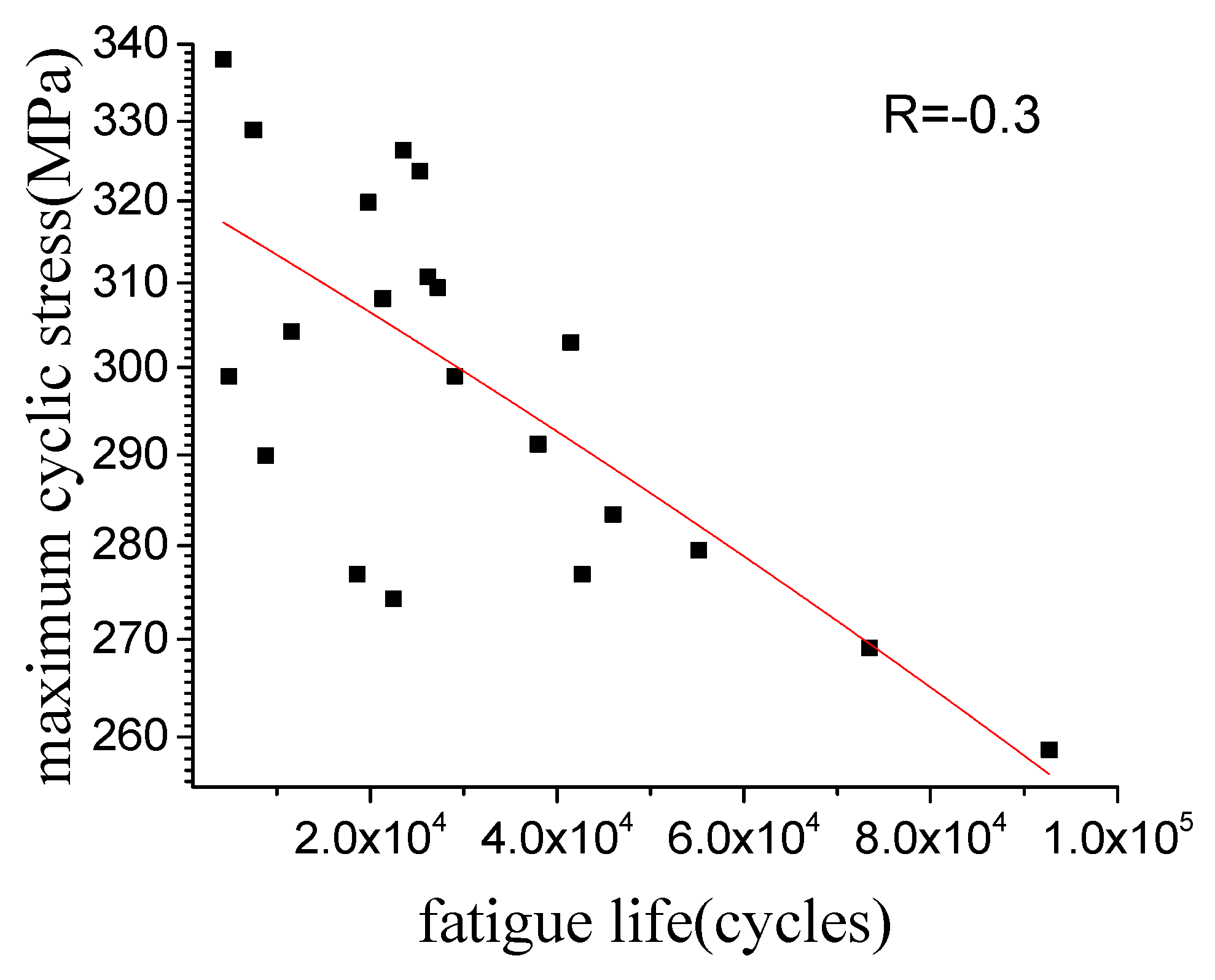

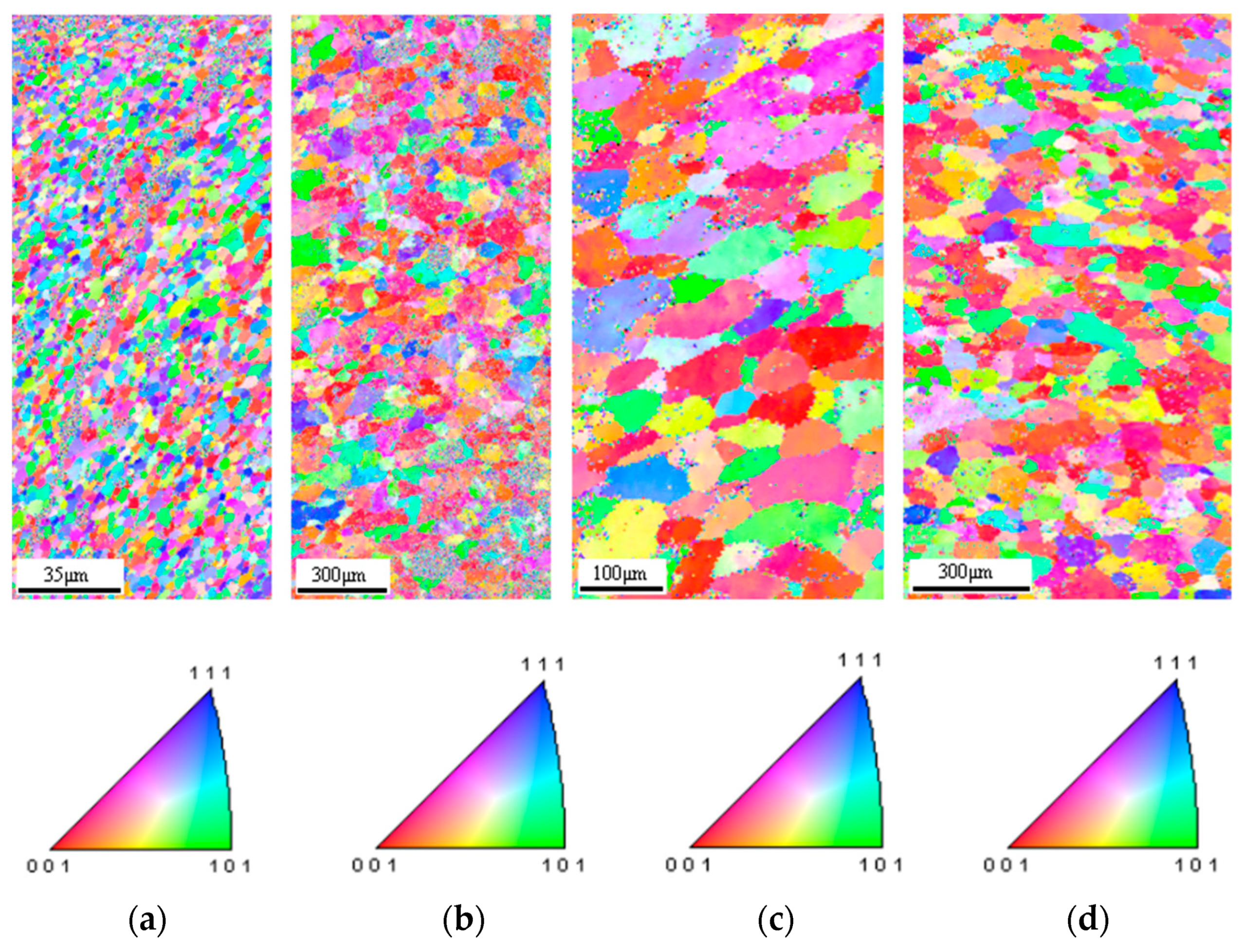
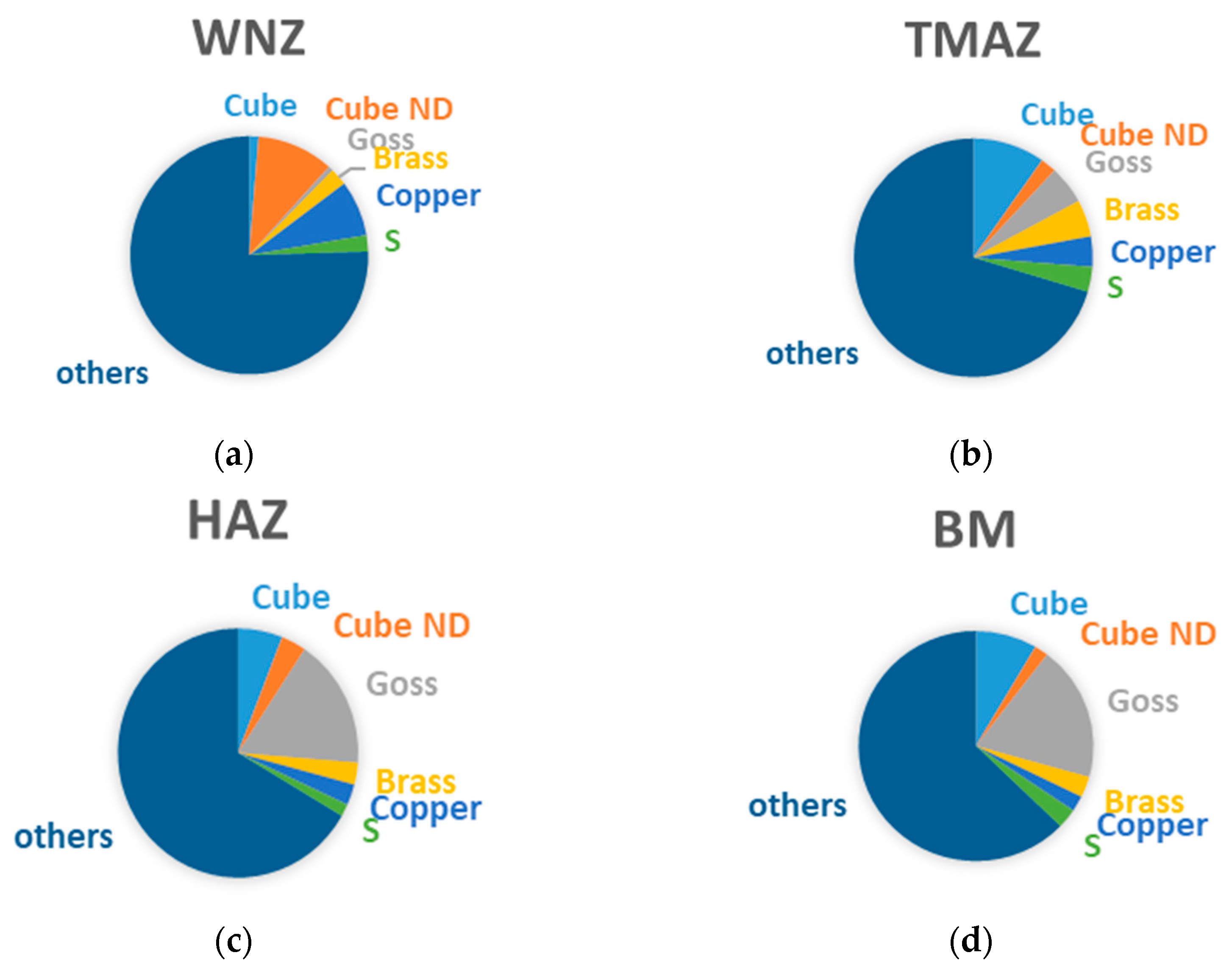
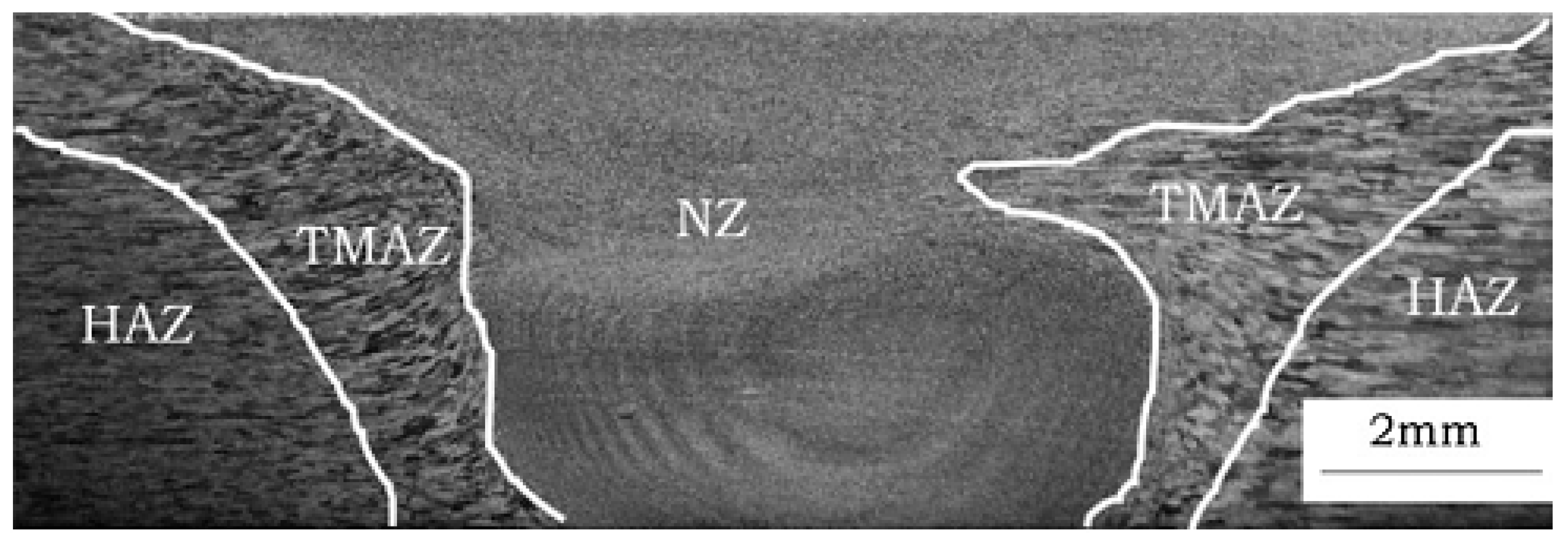
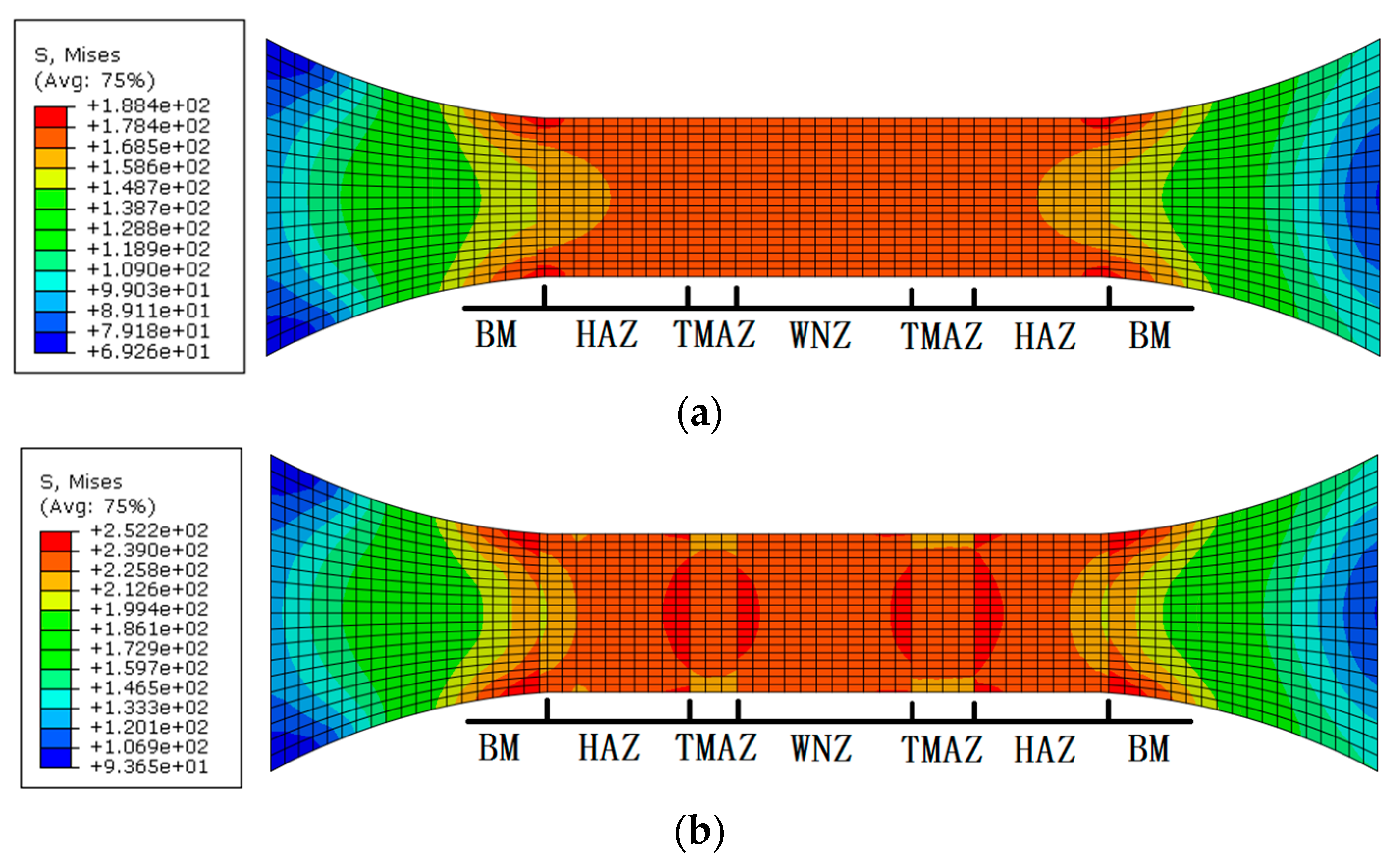


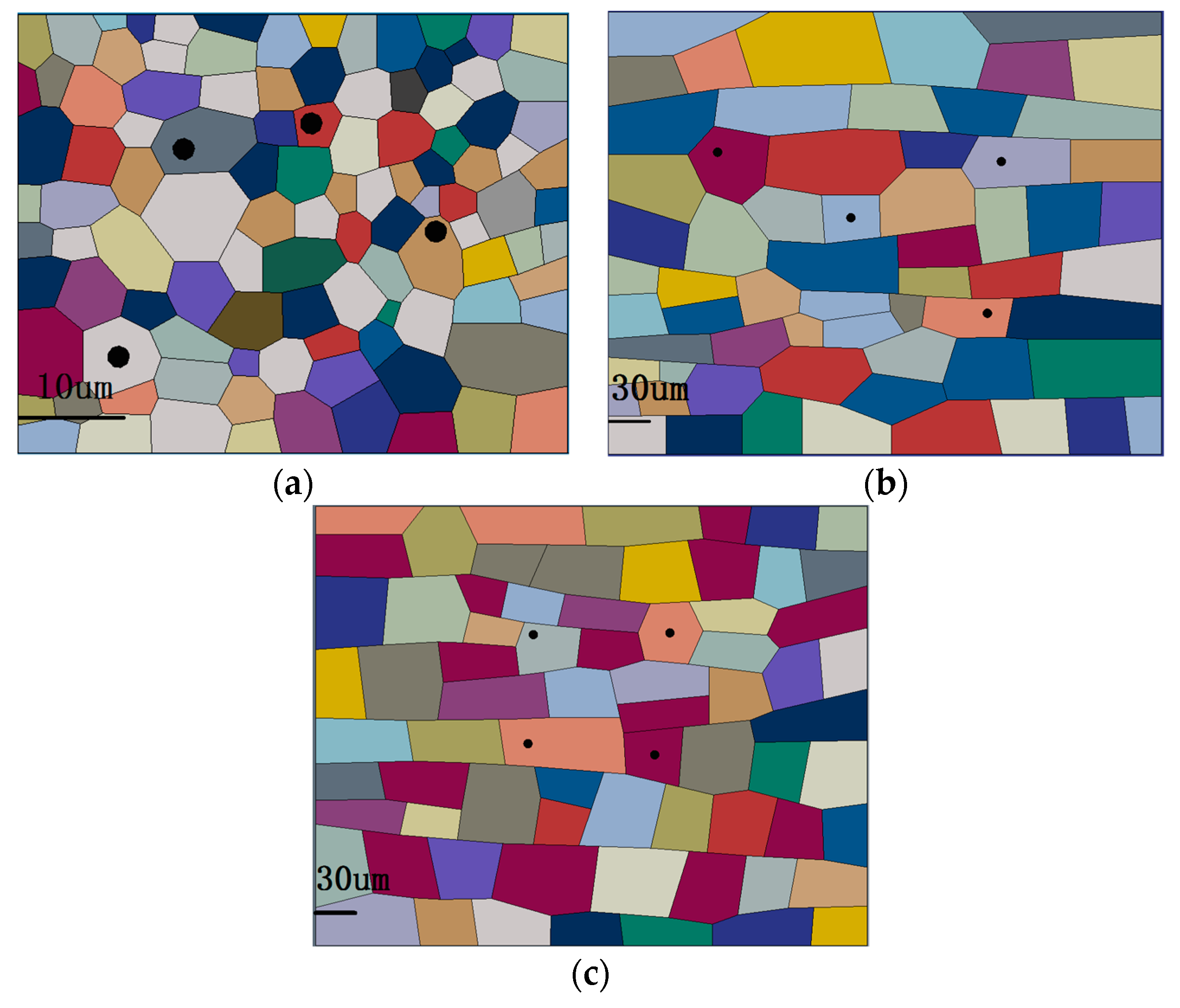
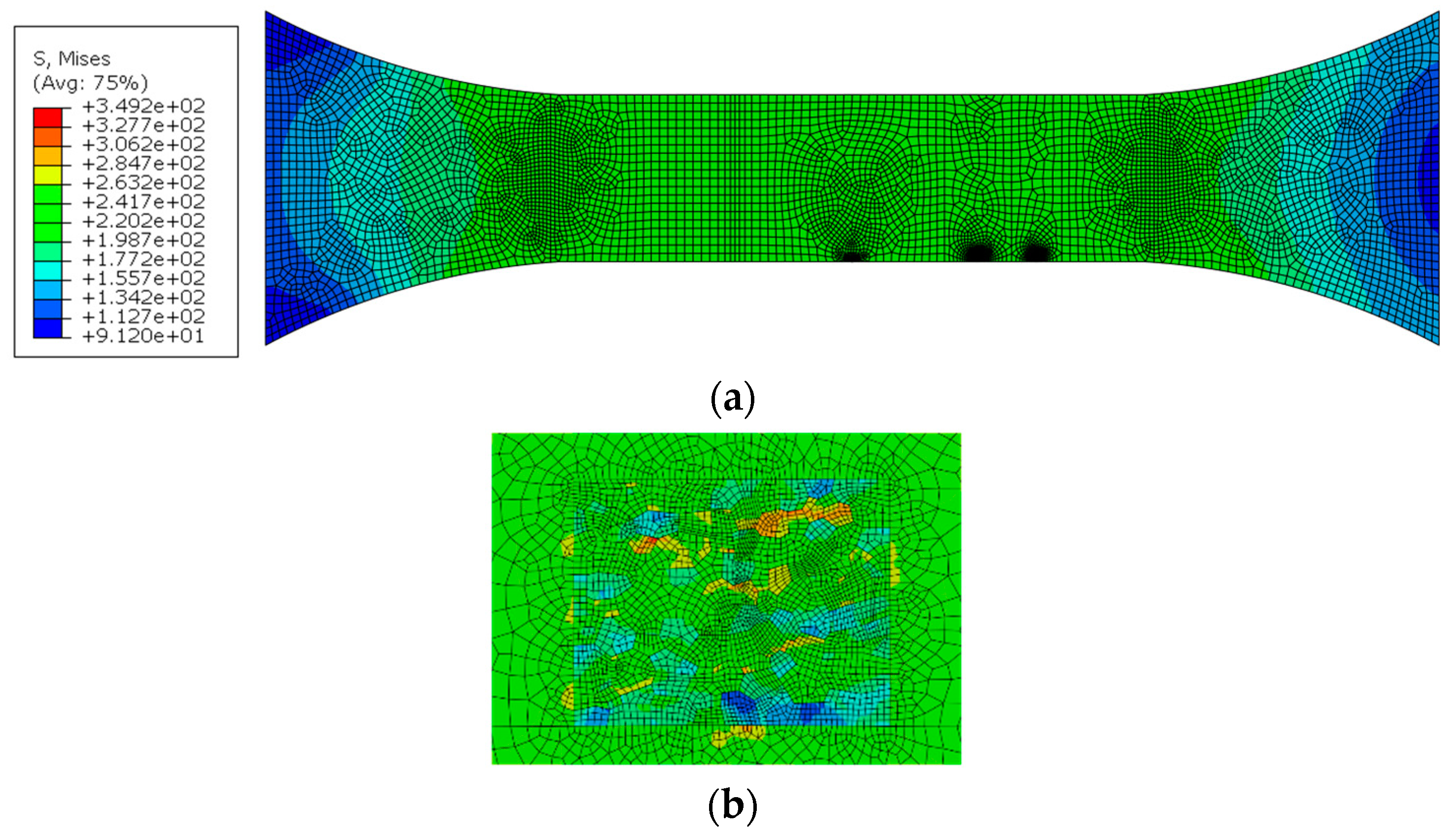



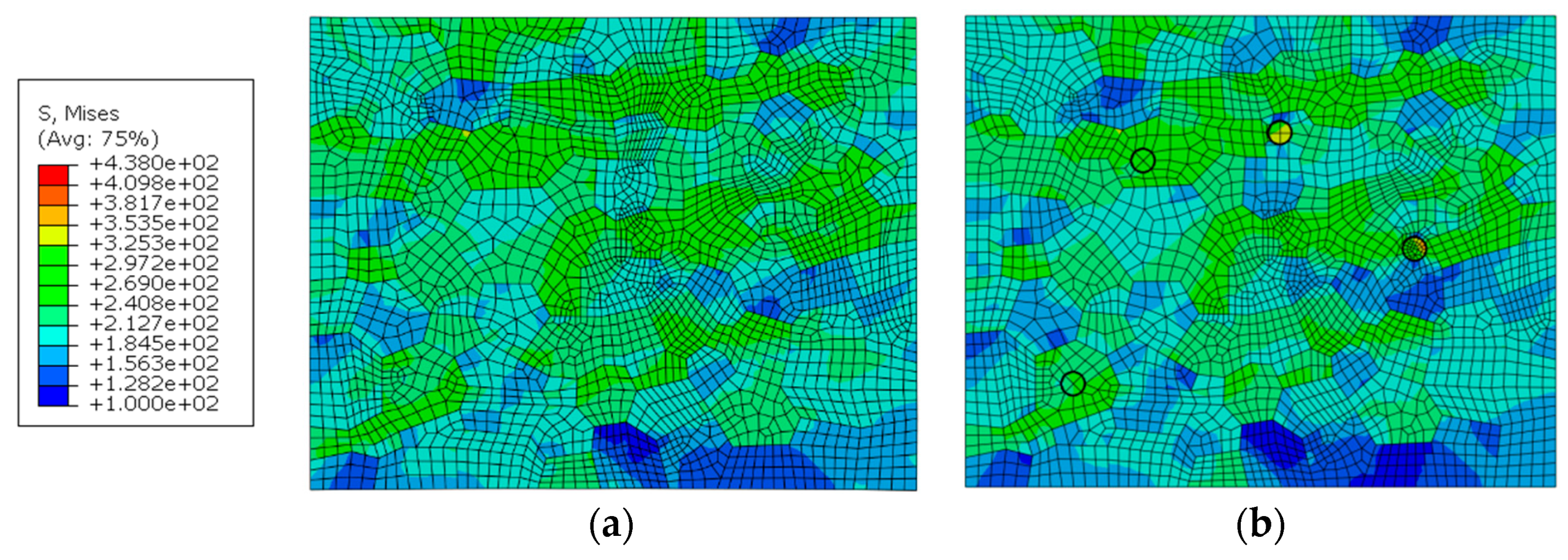
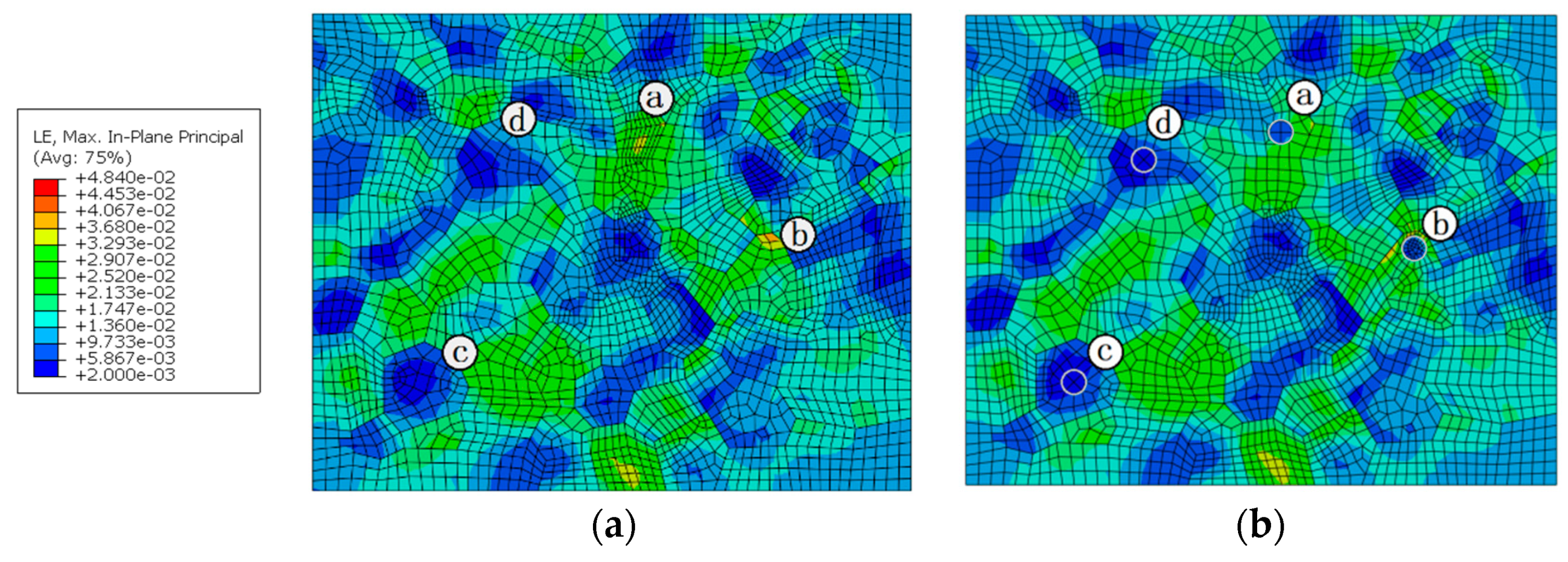
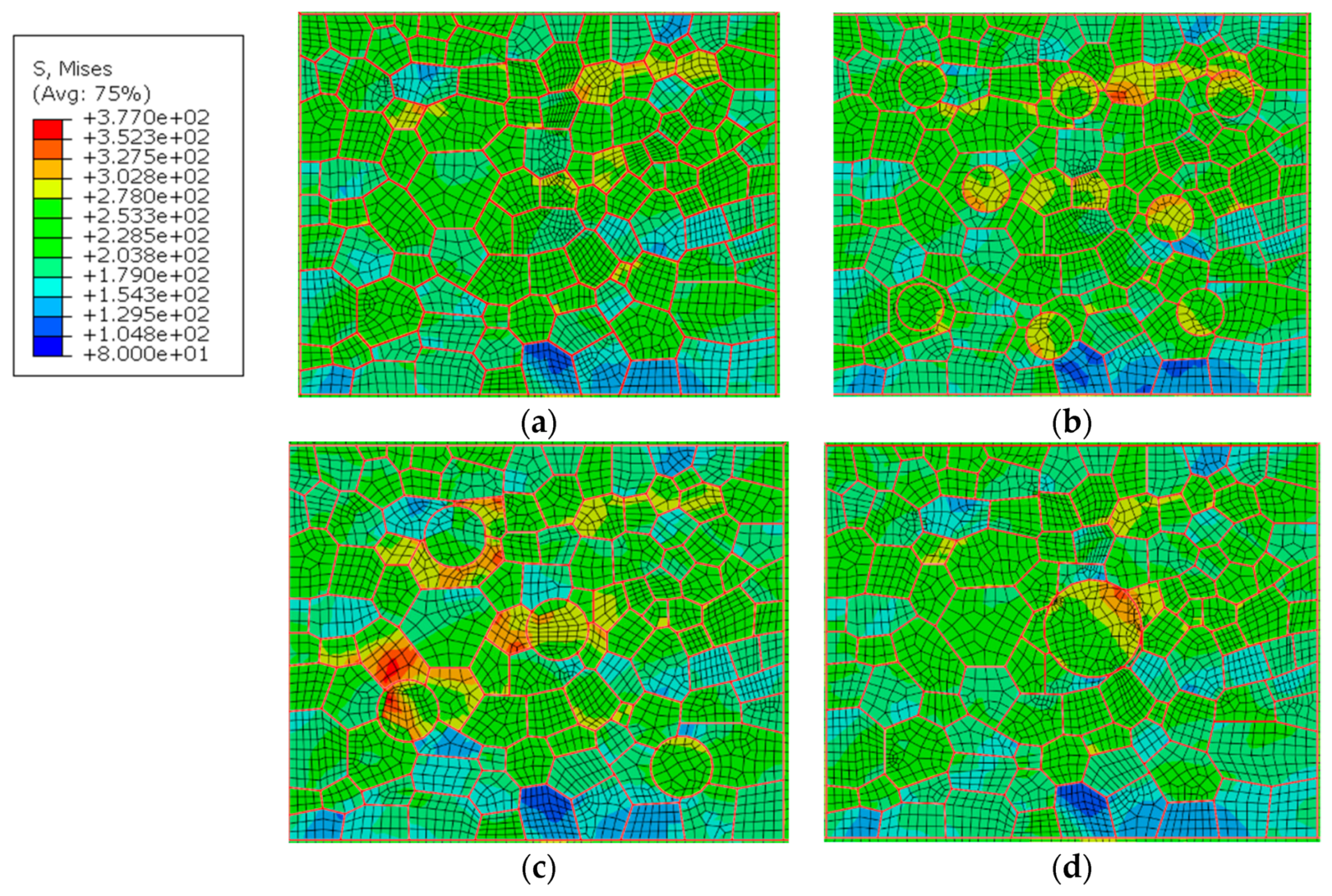

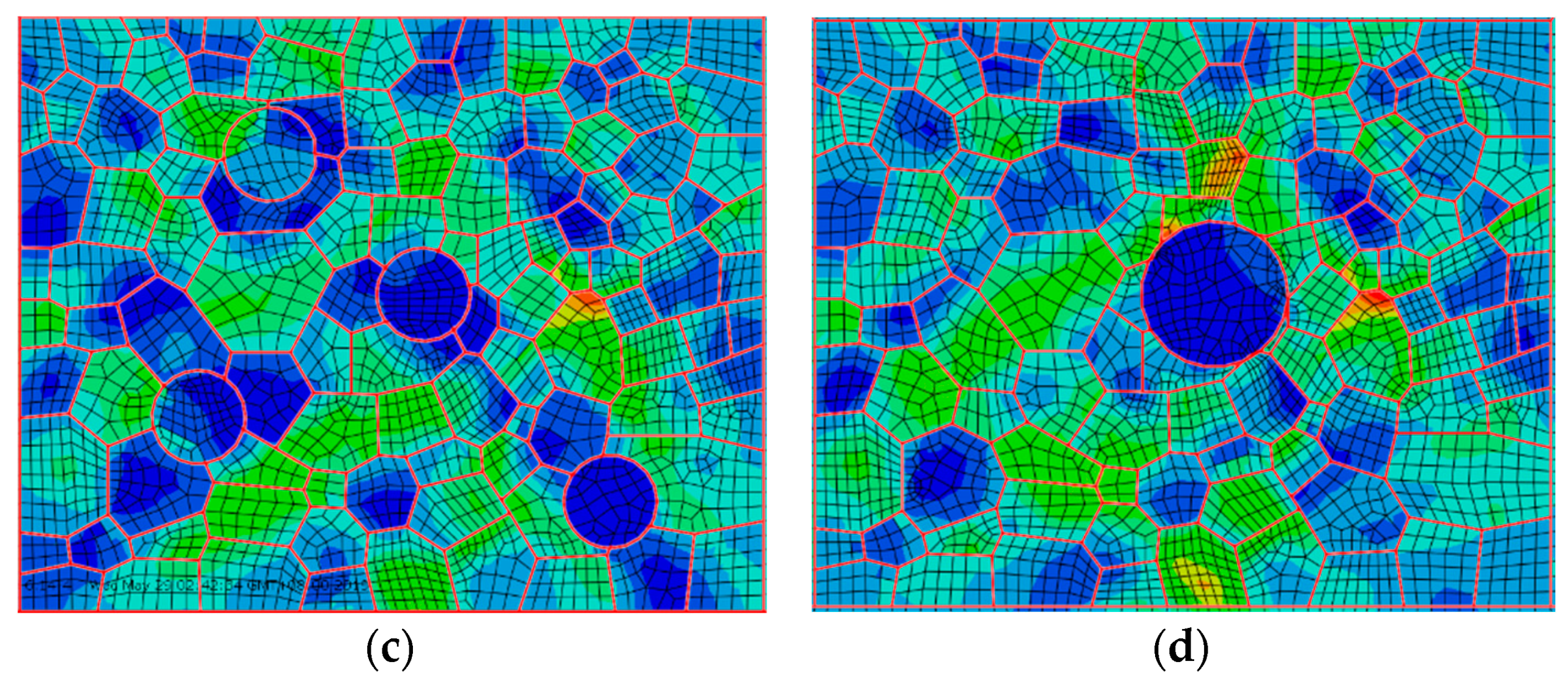
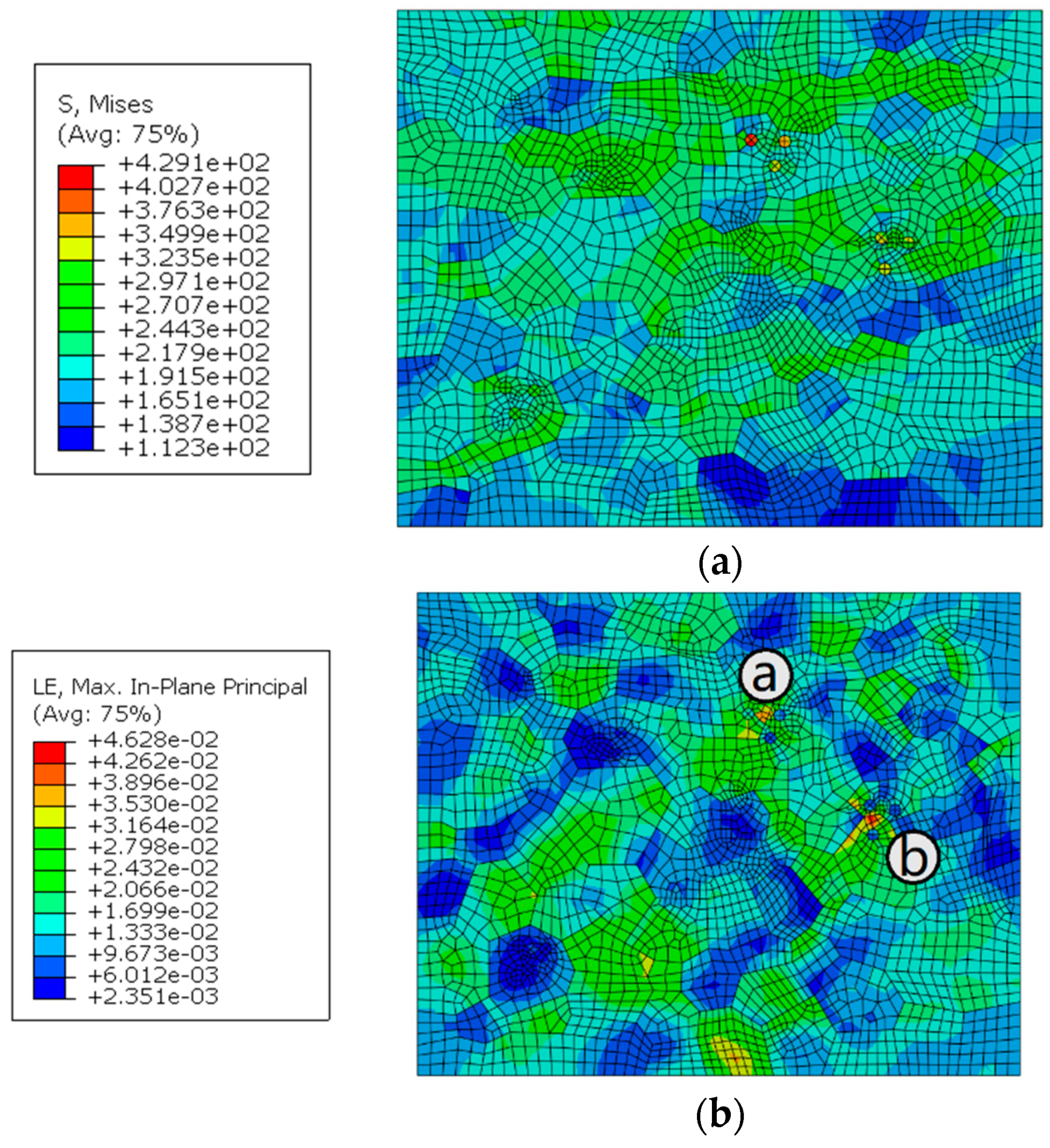
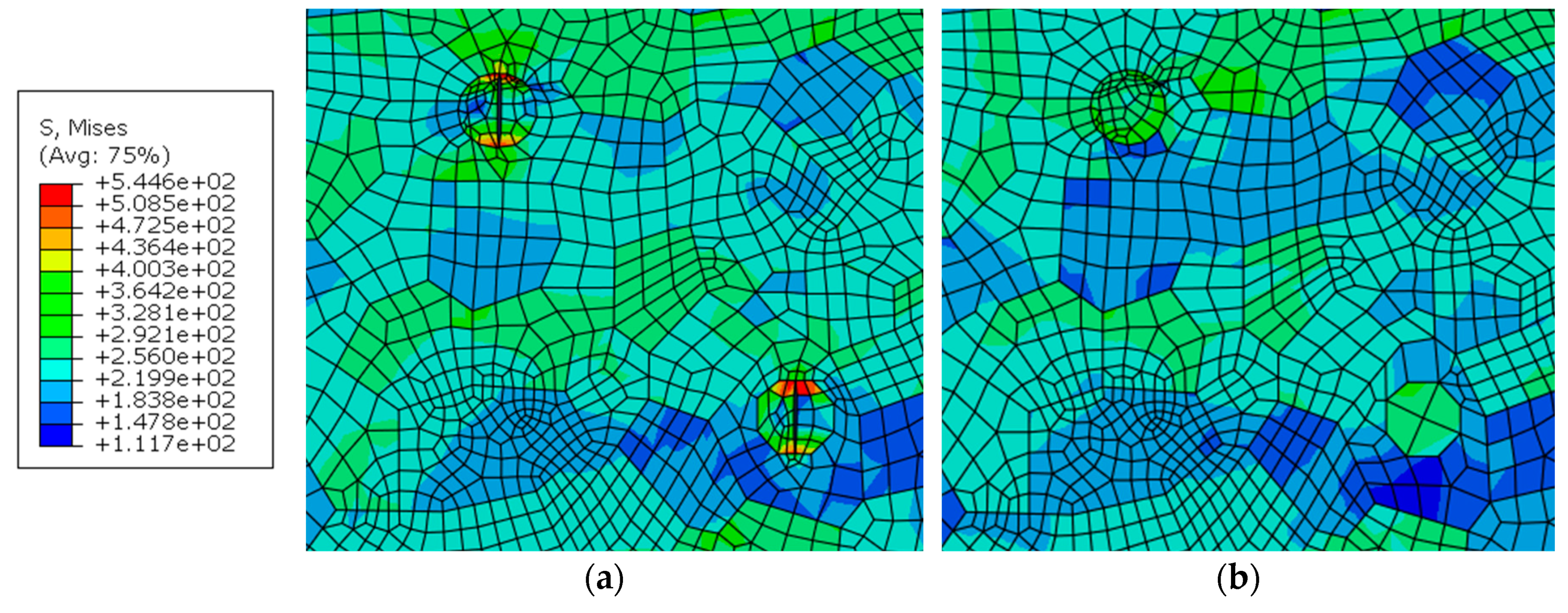
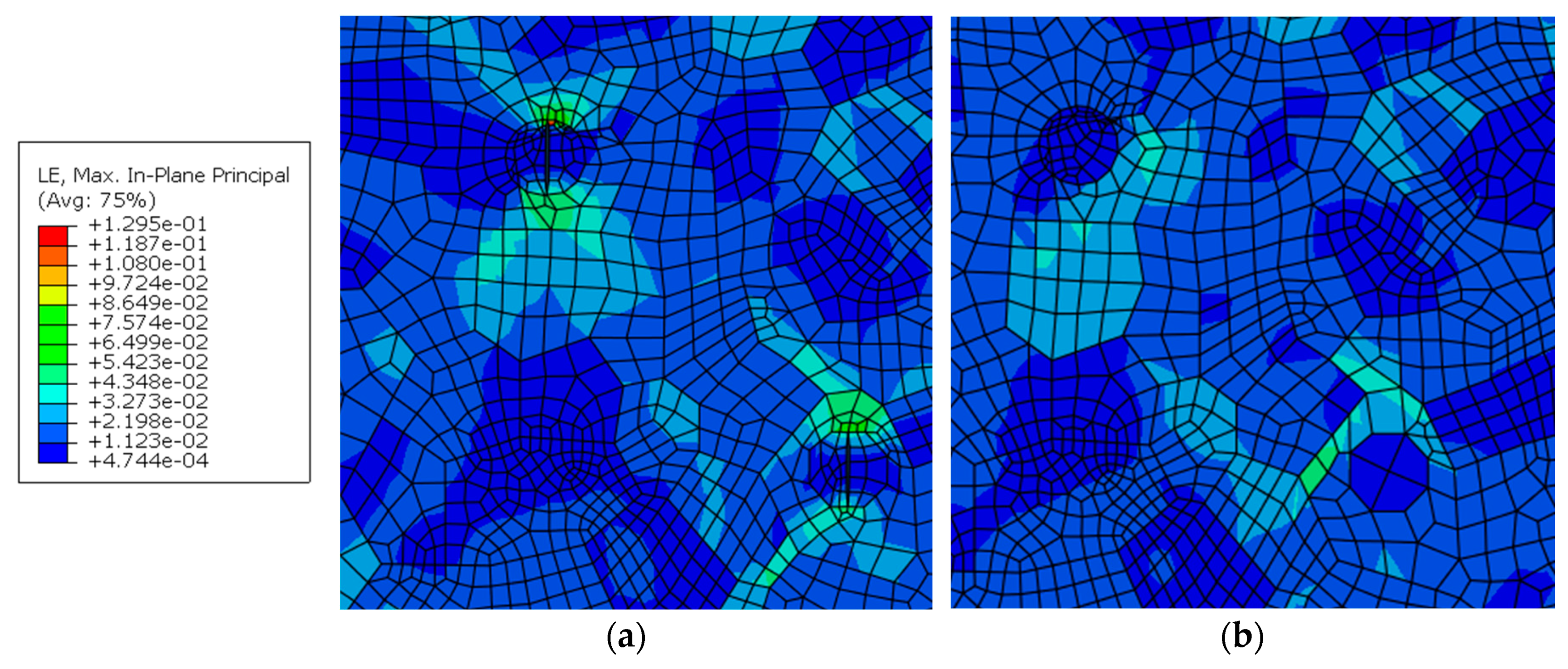
| Zones | Elastic modulus E (GPa) | Fatigue Strength Coefficient σ’f (MPa) | Fatigue Strength Exponent b | Fatigue Ductility Exponent c | Fatigue Ductility Coefficient ε’f | Cyclic Strength Coefficient K’(MPa) | Cyclic Strain Hardening Exponent n’ |
|---|---|---|---|---|---|---|---|
| BM | 57 | 514 | −0.089 | −0.465 | 0.098 | 801 | 0.192 |
| HAZ | 62 | 432 | −0.089 | −0.425 | 0.093 | 713 | 0.211 |
| TMAZ | 65 | 424 | −0.094 | −0.43 | 0.105 | 694 | 0.219 |
| WNZ | 66 | 424 | −0.094 | −0.441 | 0.118 | 668 | 0.213 |
| Adjacent grains | 1,2 | 1,3 | 2,3 | 3,4 | 3,5 | 4,5 |
| Misorientation/° | 3 | 45 | 42 | 29 | 45 | 41 |
| Adjacent grains | 1,2 | 2,3 | 3,4 | 5,6 | 1,5 | 1,6 | 1,7 | 2,7 | 2,8 | 3,8 | 3,9 | 4,8 | 4,9 |
| Misorientation/° | 11 | 17 | 9 | 48 | 35 | 43 | 52 | 44 | 41 | 55 | 43 | 49 | 35 |
| Zone | WNZ | TMAZ | HAZ |
|---|---|---|---|
| Without particles | 349 | 310 | 339 |
| Including particles | 378 | 402 | 437 |
| Stress concentration value | 1.09 | 1.30 | 1.29 |
| Zone | WNZ | TMAZ | HAZ |
|---|---|---|---|
| Without particles | 0.0384 | 0.0363 | 0.0322 |
| Including particles | 0.0484 | 0.0375 | 0.0324 |
| Strain concentration value | 1.26 | 1.03 | 1.01 |
© 2019 by the authors. Licensee MDPI, Basel, Switzerland. This article is an open access article distributed under the terms and conditions of the Creative Commons Attribution (CC BY) license (http://creativecommons.org/licenses/by/4.0/).
Share and Cite
Sun, G.; Guo, Y.; Han, X.; Shang, D.; Chen, S. Fatigue Modeling Containing Hardening Particles and Grain Orientation for Aluminum Alloy FSW Joints. Materials 2019, 12, 2024. https://doi.org/10.3390/ma12122024
Sun G, Guo Y, Han X, Shang D, Chen S. Fatigue Modeling Containing Hardening Particles and Grain Orientation for Aluminum Alloy FSW Joints. Materials. 2019; 12(12):2024. https://doi.org/10.3390/ma12122024
Chicago/Turabian StyleSun, Guoqin, Yicheng Guo, Xiuquan Han, Deguang Shang, and Shujun Chen. 2019. "Fatigue Modeling Containing Hardening Particles and Grain Orientation for Aluminum Alloy FSW Joints" Materials 12, no. 12: 2024. https://doi.org/10.3390/ma12122024




